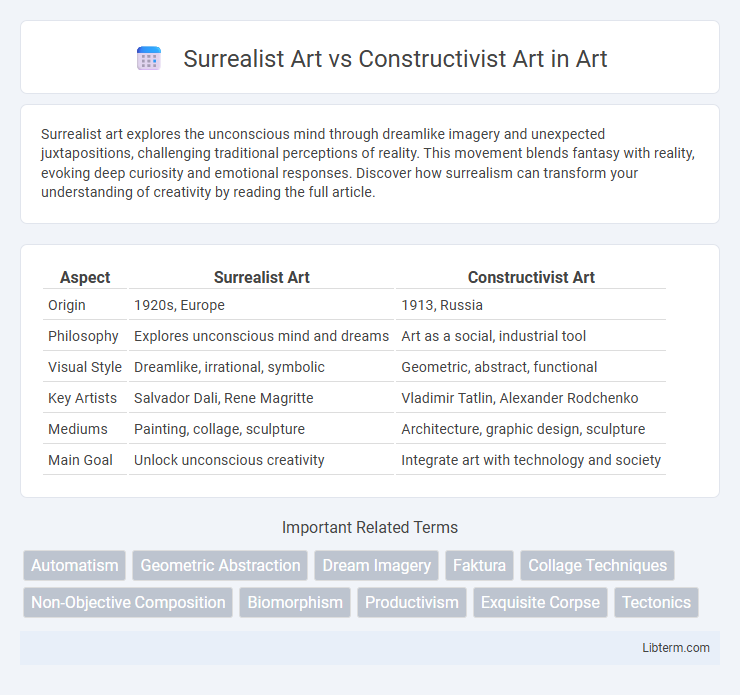Surrealist art explores the unconscious mind through dreamlike imagery and unexpected juxtapositions, challenging traditional perceptions of reality. This movement blends fantasy with reality, evoking deep curiosity and emotional responses. Discover how surrealism can transform your understanding of creativity by reading the full article.
Table of Comparison
| Aspect | Surrealist Art | Constructivist Art |
|---|---|---|
| Origin | 1920s, Europe | 1913, Russia |
| Philosophy | Explores unconscious mind and dreams | Art as a social, industrial tool |
| Visual Style | Dreamlike, irrational, symbolic | Geometric, abstract, functional |
| Key Artists | Salvador Dali, Rene Magritte | Vladimir Tatlin, Alexander Rodchenko |
| Mediums | Painting, collage, sculpture | Architecture, graphic design, sculpture |
| Main Goal | Unlock unconscious creativity | Integrate art with technology and society |
Understanding Surrealist Art: Origins and Key Principles
Surrealist art emerged in the early 1920s, rooted in the Dada movement and influenced by psychoanalytic theories of Sigmund Freud, aiming to unlock the unconscious mind through dream-like imagery and unexpected juxtapositions. Key principles of Surrealism include automatism, where artists create without conscious control, and the exploration of irrationality to challenge conventional perceptions of reality. Unlike Constructivist art, which emphasizes industrial materials and functional design for social purposes, Surrealism focuses on personal expression and the fantastical elements of the human psyche.
Defining Constructivist Art: Roots and Core Concepts
Constructivist art originated in Russia around 1913, rooted in the political and social upheaval following the Bolshevik Revolution. Its core concepts emphasize abstraction, geometric shapes, and the use of industrial materials to reflect modernity and utilitarianism. Constructivism rejects traditional aesthetic values, prioritizing functional design and the integration of art with technology and architecture.
Historical Context: Surrealism vs Constructivism
Surrealist art emerged in the early 1920s as a cultural movement influenced by the trauma of World War I and the rise of psychoanalysis, emphasizing dreamlike imagery and the unconscious mind. Constructivist art developed in post-revolutionary Russia around 1915-1920, reflecting the ideals of the Bolshevik Revolution with a focus on industrial materials, geometric forms, and functional art to serve a socialist society. While Surrealism sought to explore individual imagination and subconscious desires, Constructivism aimed at collective social progress through art integrated with technology and practical design.
Influential Artists: Surrealism and Constructivism Compared
Surrealist art, characterized by dream-like imagery and unconscious exploration, was shaped by influential artists such as Salvador Dali, Rene Magritte, and Max Ernst, who used symbolic and fantastical elements to challenge reality. Constructivist art, emerging in the Soviet Union with figures like Vladimir Tatlin, Alexander Rodchenko, and El Lissitzky, emphasized abstract geometric forms and functional design to reflect industrial modernity and social progress. The contrasting approaches highlight Surrealism's focus on individual psychology and imagination, while Constructivism prioritizes collective utility and material innovation.
Visual Language: Imagery and Symbolism in Surrealist Art
Surrealist art employs dream-like imagery and symbolic elements drawn from the subconscious, often featuring bizarre juxtapositions and fantastical scenes that challenge reality. Its visual language uses motifs such as melting clocks, distorted figures, and unexpected combinations to evoke emotions and explore the unconscious mind. In contrast, Constructivist art emphasizes geometric shapes, industrial materials, and abstract forms to convey social and political messages through a functional, rational visual structure.
Structural Forms: Geometric Precision in Constructivist Art
Constructivist art is characterized by its emphasis on geometric precision, utilizing structured shapes such as squares, circles, and triangles to create visually balanced compositions. This focus on mathematical order and industrial materials contrasts sharply with Surrealist art, which favors organic, dreamlike forms designed to evoke subconscious imagery. The structural rigidity in Constructivist works reflects a commitment to functionalism and modernity, setting it apart from the fluid, often chaotic aesthetics found in Surrealism.
Philosophical Foundations: Dreamscape vs Rationality
Surrealist art explores the unconscious mind, emphasizing dreamscapes, irrational juxtapositions, and the liberation of imagination to challenge reality's constraints. Constructivist art is grounded in rationality, functionality, and a scientific approach, promoting art as a tool for social reform and technological progress. The philosophical divergence highlights Surrealism's embrace of the subconscious and Constructivism's commitment to practicality and materialism.
Artistic Techniques: Methods and Materials Contrasted
Surrealist art employs automatic drawing, juxtapositions, and dream-like imagery using oils, collage, and mixed media to evoke subconscious experiences. Constructivist art prioritizes geometric abstraction and industrial materials like metal, glass, and plastic, emphasizing functionality and modernity. Techniques in Surrealism explore spontaneity and symbolism, while Constructivism focuses on precision, structure, and the integration of art with technology.
Cultural and Political Influences on Both Movements
Surrealist art emerged from the cultural upheaval of post-World War I Europe, heavily influenced by Freudian psychoanalysis and a desire to unlock the unconscious mind, often serving as a subtle critique of rationalism and bourgeois values. Constructivist art, rooted in the Russian Revolution, reflected the political ideology of socialism, emphasizing functionalism, industrial materials, and collective social purpose to align art with revolutionary goals. Both movements responded to their distinct historical contexts by using visual language to challenge established norms and inspire societal transformation, but Surrealism focused on individual subconscious expression while Constructivism prioritized utilitarianism and mass communication.
Legacy and Impact: Surrealism and Constructivism Today
Surrealist art continues to influence contemporary visual culture through its exploration of subconscious imagery and dreamlike aesthetics, inspiring modern artists in digital media, film, and literature. Constructivist art's legacy is evident in contemporary graphic design, architecture, and industrial art, emphasizing functionality, geometric abstraction, and social purpose. Both movements have shaped modern artistic paradigms by challenging traditional forms and integrating avant-garde concepts into mainstream creative practices.
Surrealist Art Infographic

 libterm.com
libterm.com